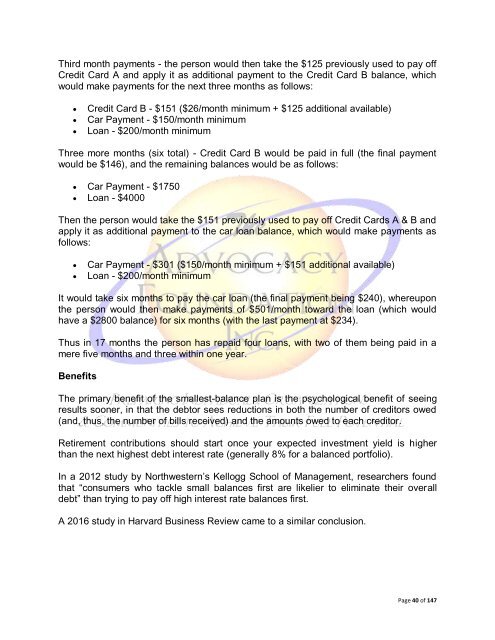Debt Reduction & Debt Relief
Debt Reduction & Debt Relief
Debt Reduction & Debt Relief
Create successful ePaper yourself
Turn your PDF publications into a flip-book with our unique Google optimized e-Paper software.
Third month payments - the person would then take the $125 previously used to pay off<br />
Credit Card A and apply it as additional payment to the Credit Card B balance, which<br />
would make payments for the next three months as follows:<br />
<br />
<br />
<br />
Credit Card B - $151 ($26/month minimum + $125 additional available)<br />
Car Payment - $150/month minimum<br />
Loan - $200/month minimum<br />
Three more months (six total) - Credit Card B would be paid in full (the final payment<br />
would be $146), and the remaining balances would be as follows:<br />
Car Payment - $1750<br />
Loan - $4000<br />
Then the person would take the $151 previously used to pay off Credit Cards A & B and<br />
apply it as additional payment to the car loan balance, which would make payments as<br />
follows:<br />
<br />
<br />
Car Payment - $301 ($150/month minimum + $151 additional available)<br />
Loan - $200/month minimum<br />
It would take six months to pay the car loan (the final payment being $240), whereupon<br />
the person would then make payments of $501/month toward the loan (which would<br />
have a $2800 balance) for six months (with the last payment at $234).<br />
Thus in 17 months the person has repaid four loans, with two of them being paid in a<br />
mere five months and three within one year.<br />
Benefits<br />
The primary benefit of the smallest-balance plan is the psychological benefit of seeing<br />
results sooner, in that the debtor sees reductions in both the number of creditors owed<br />
(and, thus, the number of bills received) and the amounts owed to each creditor.<br />
Retirement contributions should start once your expected investment yield is higher<br />
than the next highest debt interest rate (generally 8% for a balanced portfolio).<br />
In a 2012 study by Northwestern’s Kellogg School of Management, researchers found<br />
that “consumers who tackle small balances first are likelier to eliminate their overall<br />
debt” than trying to pay off high interest rate balances first.<br />
A 2016 study in Harvard Business Review came to a similar conclusion.<br />
Page 40 of 147

















